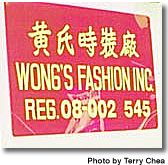
Keeping us
in stitches
Page 2
that make up the vast industrial underbelly of the American garment industry. Factories like this lie at the bottom of an industry food chain that is dominated by powerful retailers. The retailers buy garments from manufacturers who generally use small contractors like Wong's to make the garments.
In recent years, the garment industry has come under increasing attack for its labor abuses, which critics say has spawned the return of the industrial "sweatshops" that many thought had gone out of existence a century ago. Fierce competition among contractors to fill orders has been largely responsible for driving down wages and working conditions for garment workers.
Despite laws and regulations and government campaigns against them, such low-wage establishments are once again common in the U.S. garment industry. Waves of immigration in the last two decades have brought large numbers of immigrants, both legal and illegal, who are anxious to work and willing to accept jobs in such factories, even if it means working for pay at or below the minimum wage.
 Like
the seamstresses at Wong's Fashion, the vast majority of garment workers
in Bay Area sewing factories are Asian immigrant women who immigrated
from China, Hong Kong, Korea, Vietnam and other Asian countries. For recent
immigrant women with limited education and language skills, work in such
factories is often the only way to earn a living.
Like
the seamstresses at Wong's Fashion, the vast majority of garment workers
in Bay Area sewing factories are Asian immigrant women who immigrated
from China, Hong Kong, Korea, Vietnam and other Asian countries. For recent
immigrant women with limited education and language skills, work in such
factories is often the only way to earn a living.
A reporter who passed through the factory door finds an efficient assembly line of workers toiling beneath bright, florescent lights that hang from the high ceiling on metal chains. Industrial fans turn and blow a balmy breeze while the Cantonese pop bounces off the warehouse walls. Bins of discarded fabric and giant rolls of textile clutter the factory floor. Three young workers in the back of the factory work the press, releasing clouds of steam as they iron neat pleats into the dresses.
Work at Wong's sewing shop is long and tedious. Each woman looks singularly absorbed in the task before her, pushing and pulling the colorful strips of satin beneath the bobbing needle of the sewing machine. Few outsiders ever venture into the world of Wong's Fashion, and so the workers look up and stare suspiciously when they spot a reporter wandering across on the factory floor.
Although there are 60 Chinese women working side by side in the same room, there is little room for idle chatter. The shop is devoid of the lively banter of Cantonese that fills San Francisco's Chinese restaurants on Saturday afternoons over tea and dim sum. But the women labor diligently nonetheless, understanding that work in a garment factory, like a revolution, was never supposed to be a tea party.
Pius
Lee
Political star
Peter
Louis
Feng shui master
Phoebe
Man
21st century artist
Martin
Yan
Celebrity chef
Coming soon
In
late May, journalism students from
UC Berkeley will travel to
Hong Kong. Watch for their reports.